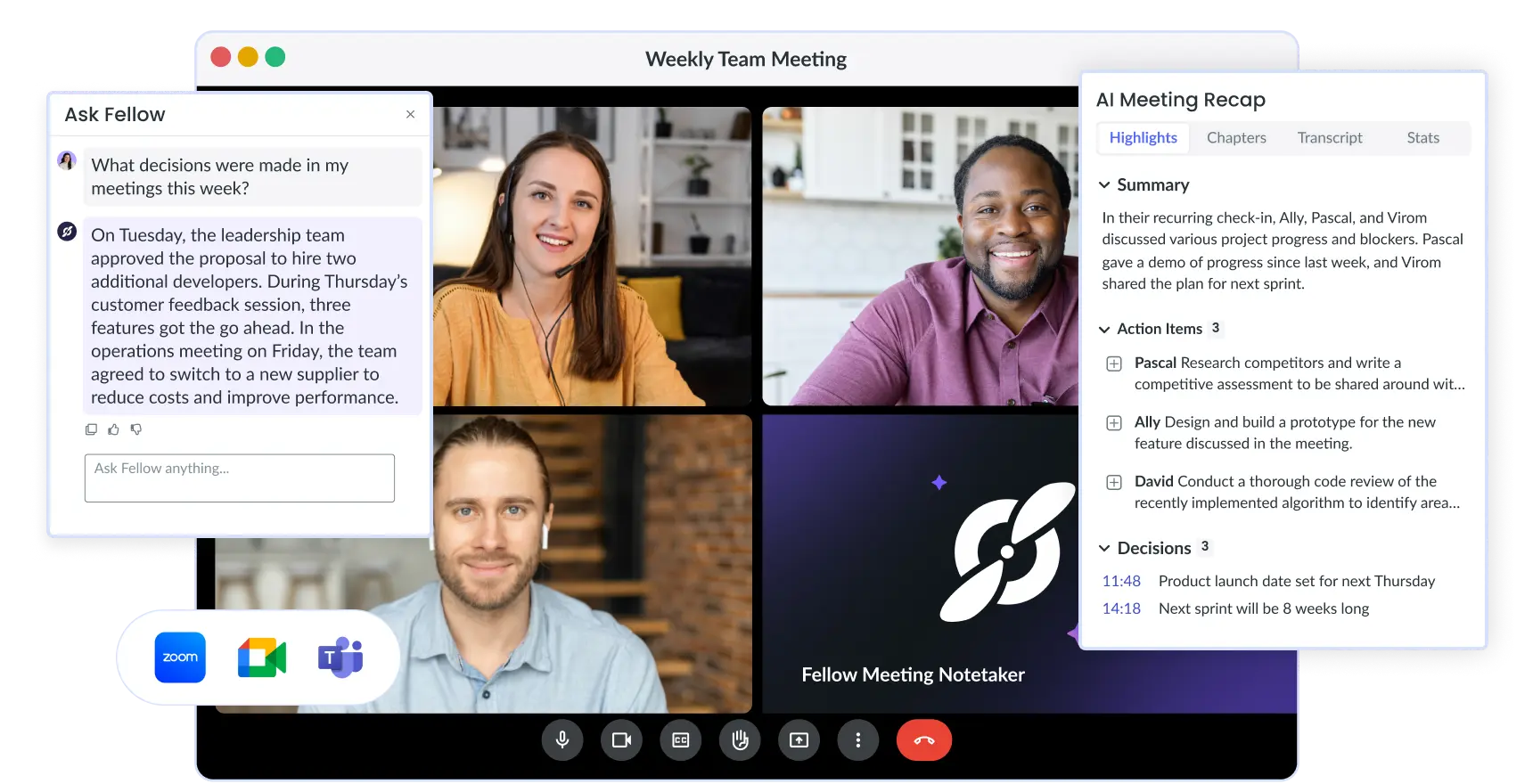5 Meeting Minutes Examples, Templates, and Best Practices for 2026
Sep 3, 2025
•
9
MIN READ
AI Summary by Fellow
At any organization, meetings are where most decisions take place. Whether you’re in a board meeting, an executive goal review session, or a customer conversation, great organizers know it’s essential to have an agenda to guide the discussion and to share clear meeting minutes immediately afterward.
But if you’re moving from one meeting to the next all day, creating agendas and sending minutes for each can quickly become time-consuming.
Why meeting minutes still matter
Meeting minutes aren’t just notes, they’re the record of what happened, what was decided, and what comes next. From boardrooms to sprint planning, they capture key details like attendees, topics, and action items so everyone stays aligned.
In many industries, minutes aren’t optional: they’re required. Many of our customers at Fellow work in highly regulated industries like government, healthcare, and finance, where meeting minutes are required for compliance and legal protection.
However, we also see teams outside these sectors rely on meeting minutes to stay accountable, avoid misunderstandings, and keep decisions moving work forward.
Who should be appointed to take meeting minutes?
Traditionally, admins, project managers, or team leads handle meeting minutes. Smaller teams sometimes rotate the responsibility so no one misses out on contributing to the discussion.
But in the AI era, there’s a smarter option. Now, you can offload the task to AI meeting assistants and notetakers such as Fellow, the most accurate and secure AI meeting assistant.
Fellow automatically generates a complete transcript and concise minutes, so everyone stays accountable and informed, even if they couldn’t attend. That way, the whole team can focus on decisions, not documentation.
5 types of meeting minutes (with real examples)
Action-oriented meeting minutes
These focus almost entirely on decisions made and actions assigned. They leave out most of the discussion and capture who is responsible for what, along with deadlines.
Purpose: Capture tasks and responsibilities clearly.
Example:
Decision: Launch pilot of onboarding program on Oct 1.
Action Item 1: Sarah (Product) will finalize training materials by Sept 15.
Action Item 2: Alex (Marketing) to draft customer comms by Sept 20.
Action Item 3: Finance team to confirm budget allocation by Sept 10.
2. Discussion minutes
These provide a more detailed record of the conversation itself. They capture the flow of discussion, key points raised, arguments for and against, and context behind decisions.
Purpose: Provide context around decisions.
Example:
Topic: Training Materials
Sarah noted current documents are too technical. John suggested adding visuals and flowcharts. Group agreed this would make onboarding easier for non-technical users.Topic: Marketing Communications
Alex raised concern that sending emails too early could confuse customers. The group decided to align comms timing with training completion.Decision: Materials finalized by Sept 15; comms to be drafted by Sept 20.
3. Verbatim meeting minutes
A word-for-word transcript of everything said. Rarely used in everyday business because they’re long and hard to process, but common in legal, governmental, or high-stakes regulatory settings.
Purpose: Full word-for-word record (rare outside formal/legal settings).
Example:
Sarah: “The current documents are too technical for end users. I propose we create a simplified version with visuals.”
John: “Yes, but visuals will require design resources. Do we have bandwidth?”
Alex: “If we send communications too early, customers might expect access before the product is ready.”
Chair: “So, we’re agreeing: Sarah will finalize by Sept 15, Alex by Sept 20. Correct?”
Group: “Agreed.”
Decision-only minutes
These strip things down to just the outcomes: what decisions were made, with no record of the debate or reasoning. They’re short and efficient, but don’t provide context.
Purpose: Highlight outcomes only, no context.
Example:
Approved: Pilot launch date is Oct 1.
Approved: Training materials deadline is Sept 15.
Approved: Marketing comms deadline is Sept 20.
Approved: Budget allocation deadline is Sept 10.
Informal meeting minutes (or notes)
A lightweight version, often just a bulleted list of takeaways, reminders, and action items. These are common in startups, internal team meetings, or working groups where speed matters more than formality.
Purpose: Lightweight reminders, often for internal team use.
Example:
Pilot launch → Oct 1
Training → Sarah, Sept 15
Comms → Alex, Sept 20
Budget → Finance, Sept 10
Pro Tip: Don’t start from scratch every time. Fellow comes with pre-built meeting templates, from action-oriented to discussion-driven, that you can use as-is or customize for your team. That means you get professional, consistent documentation in seconds, while Fellow’s AI meeting notetaker handles the busywork of recording, transcribing, and sharing your notes automatically.

Meeting minutes templates
Board meeting minutes
Ensure your next board meeting is collaborative, well-structured and efficient with this board meeting minutes template.

Project meeting minutes
Ideal for project managers and teams, this template helps share updates, discuss roadblocks, and assign tasks.

Staff meeting minutes
Run your weekly syncs like a pro with this template curated by award-winning SaaS founder coach, Dan Martell.

6 best practices for great meeting minutes
Whether you use an AI meeting assistant to capture minutes automatically or prefer to manually write them yourself, these six best practices will help you create clear records that drive alignment and accountability – no matter if you work in healthtech, finance, tech, or any other industry.
1. Summarize the purpose and outcomes
Don’t just list what was discussed, capture why the meeting happened and what was achieved. This context helps stakeholders who weren’t in the room quickly understand the decisions that were made.
2. Use a structured template
A consistent format makes minutes easy to read and reference later. Meeting minutes templates also save time and ensure you never miss key details, whether you’re documenting a clinical review, a client portfolio update, or a sprint retrospective.
3. Document the essentials
Every set of minutes should note the date, time, participants, and agenda items. In regulated industries like healthcare and finance, these details provide vital documentation for compliance and audit trails.
4. Capture decisions and action items clearly
Focus on outcomes, not a word-for-word transcript. Note what was decided, who owns each action item, and when it’s due. This turns your minutes into a roadmap for accountability and follow-through.
5. Automate with AI for speed and accuracy
Drafting and sharing minutes manually is time-consuming, and prone to human error. Remember that a secure AI meeting assistant like Fellow automatically records, transcribes, and summarizes meetings, then carries action items into your next agenda. That means you can stay engaged in the conversation while Fellow handles the documentation.
6. Share promptly
Meeting minutes lose value if they sit in someone’s inbox. Distribute them right after the meeting so colleagues - whether in the room, remote, or catching up later - have the context and action items they need to keep work moving forward. With Fellow's AI meeting recaps, this happens automatically, ensuring no one misses a decision.
Improve the quality of your meeting minutes with AI
Writing and sharing minutes after every meeting keeps teams aligned, but it shouldn’t feel like another chore. That’s where automation comes in.
With Fellow’s AI meeting notetaker, minutes practically write themselves. You’ll get a clean recap with timestamps, key decisions, action items, and even suggested topics for your next session. Sensitive details? Fellow lets you permanently redact parts of the recording, summary, or transcript, so your documentation stays private and compliant, whether you’re in healthtech, finance, or tech.
🔐 Learn more about Fellow's privacy controls.
And if someone misses a call, they can simply ask Fellow what was discussed or which action items they own. No more scrambling to remember who said what: your team stays focused on decisions, while Fellow handles the documentation.
Frequently asked questions
Record, transcribe and summarize every meeting with the only AI meeting assistant built with privacy and security in mind.






